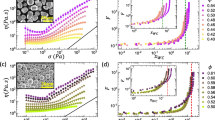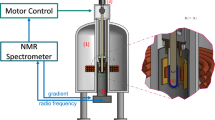Abstract
To understand the dynamic process of polymer detachment, it is necessary to determine the mean detachment time of a single breakable link, which is modeled as a spring. Normally, this time can be viewed as the escape of a Brownian particle from the potential well of the spring. However, as the free dangling length of the polymer chain increases, the conformational entropy of the chain is affected by geometric confinement. It means that the wall exerts a repulsive force on the chain, resulting in accelerated link detachment from a macroscopic perspective. In this work, we investigate the effect of entropy on the detachment rate in the case where the substrate is spherical. We demonstrate that spherical confinement accelerates chain detachment both inside and outside the sphere. An analytical expression for the mean detachment time of breakable links is given, which includes an additional pre-factor that is related to the partition function. Additionally, we analyze the expressions for entropic forces inside the sphere, outside the sphere, and on a flat wall, comparing their magnitudes to explain the difference in mean detachment time.
Similar content being viewed by others
References
Claesson, P. M.; Blomberg, E.; Fröberg, J. C.; Nylander, T.; Arnebrant, T. Protein interactions at solid surfaces. Adv. Colloid Interface Sci. 1995, 57, 161–227.
Lipowsky, R. Flexible membranes with anchored polymers. Colloids Surf. A 1997, 128, 255–264.
Ayscough, K. R. In vivo functions of actin-binding proteins. Curr. Opin. Cell Biol. 1998, 10, 102–111.
Smith, D. E.; Tans, S. J.; Smith, S. B.; Grimes, S.; Anderson, D. L.; Bustamante, C. The bacteriophage φ29 portal motor can package DNA against a large internal force. Nature 2001, 413, 748–752.
Aliee, M.; Najafi, A. Mechanical properties of an adsorbed elastic polymer in contact with a rigid membrane. Phys. Rev. E 2008, 78, 051802.
Paturej, J.; Dubbeldam, J. A.; Rostiashvili, V. G.; Milchev, A.; Vilgis, T. A. Force spectroscopy of polymer desorption: theory and molecular dynamics simulations. Soft Matter 2014, 10, 2785–2799.
Chaudhuri, A.; Chaudhuri, D. Forced desorption of semiflexible polymers, adsorbed and driven by molecular motors. Soft Matter 2016, 12, 2157–2165.
Li, B.; Abel, S. M. Shaping membrane vesicles by adsorption of a semiflexible polymer. Soft Matter 2018, 14, 185–193.
Saltzman, W. M.; Kyriakides, T. R. Cell interactions with polymers. In Principles of Tissue Engineering. 4th Ed. Academic Press, 2020, 275–293.
Lee, J. H.; Gustin, J. P.; Chen, T. Vesicle-biopolymer gels: Networks of surfactant vesicles connected by associating biopolymers. Langmuir 2005, 21, 26–33.
Skulason, H.; Frisbie, C. D. Direct detection by atomic force microscopy of single bond forces associated with the rupture of discrete charge-transfer complexes. J. Am. Chem. Soc. 2002, 124, 15125–15133.
Stout, A. L. Detection and characterization of individual intermolecular bonds using optical tweezers. Biophy. J. 2001, 80, 2976–2986.
Hanke, F.; Livadaru, L.; Kreuzer, H. J. Adsorption forces on a single polymer molecule in contact with a solid surface. Europhys. Lett. 2005, 69, 242–248.
Kierfeld, J. Force-induced desorption and unzipping of semiflexible polymers. Phys. Rev. Lett. 2006, 97, 058302.
Essevaz-Roulet, B.; Bockelmann, U.; Heslot, F. Mechanical separation of the complementary strands of DNA. Proc. Natl. Acad. Sci. U. S. A. 1997, 94, 11935–11940.
Cocco, S.; Monasson, R.; Marko, J. F. Force and kinetic barriers to unzipping of the DNA double helix. Proc. Natl. Acad. Sci. U. S. A. 2001, 98, 8608–8613.
Zou, S.; Schönherr, H.; Vancso, G. J. Stretching and rupturing individual supramolecular polymer chains by AFM. Angew. Chem. 2005, 44, 978–981.
Hugel, T.; Grosholz, M.; Clausen, S. H.; Pfau, A.; Gaub, H.; Seitz, M. Elasticity of single polyelectrolyte chains and their desorption from solid supports studied by AFM based single molecule force spectroscopy. Macromolecules 2001, 34, 1039–1047.
Benetatos, P.; Frey, E. Depinning of semiflexible polymers. Phys. Rev. E 2003, 67, 051108.
Florio, G.; Puglisi, G.; Giordano, S. Role of temperature in the decohesion of an elastic chain tethered to a substrate by onsite breakable links. Phys. Rev. Res. 2020, 2, 033227.
Paturej, J.; Milchev, A.; Rostiashvili, V. G.; Vilgis, T. A. Polymer detachment kinetics from adsorbing surface: theory, simulation and similarity to infiltration into porous medium. Macromolecules 2012, 45, 4371–4380.
Singh, N.; Singh, Y. Statistical theory of force-induced unzipping of DNA. Eur. Phys. J. E 2005, 17, 7–19.
Jánosi, I. M.; Chrétien, D.; Flyvbjerg, H. Structural microtubule cap: stability, catastrophe, rescue, and third stat. Biophys. J. 2002, 83, 1317–1330.
Kallrot, N.; Linse, P. Dynamic study of single-chain adsorption and desorption. Macromolecules 2007, 40, 4669–4679.
Zhao, S. L.; Wu, J.; Gao, D.; Wu, J. Z. Gaussian fluctuations in tethered DNA chains. J. Chem. Phys. 2011, 134, 065103.
Lee, C. T.; Terentjev, E. M. Hard-wall entropic effect accelerates detachment of adsorbed polymer chains. Phys. Rev. E 2019, 100, 032501.
Schweizer, K. S.; Saltzman, E. J. Entropic barriers, activated hopping, and the glass transition in colloidal suspensions. J. Chem. Phys. 2003, 119, 1181–1196.
Wozinski, A.; Iwaniszewski, J. Relaxation through an asymmetric fluctuating potential barrier. Phys. Rev. E 2009, 80, 011129.
Fiasconaro, A.; Spagnolo, B. Resonant activation in piecewise linear asymmetric potentials. Phys. Rev. E 2011, 83, 041122.
Hummer, G.; Szabo, A. Kinetics from nonequilibrium single-molecule pulling experiments. Biophys. J. 2003, 85, 5–15.
Frantz, P.; Granick, S. Kinetics of polymer adsorption and desorption. Phys. Rev. Lett. 1991, 66, 899–902.
Frantz, P.; Granick, S. Exchange kinetics of adsorbed polymer and the achievement of conformational equilibrium. Macromolecules 1994, 27, 2553–2558.
Goeler, F. V.; Muthukumar, M. Adsorption of polyelectrolytes onto curved surfaces. J. Chem. Phys. 1994, 100, 7796–7803.
Ball, R. C.; Blunt, M.; Barford, W. Can surface bound states be induced by interfacial roughness? J. Phys. A. 1989, 22, 2587–2595.
Moore, N. W.; Kuhl, T. L. The role of flexible tethers in multiple ligand-receptor bond formation between curved surfaces. Biophys. J. 2006, 91, 1675–1687.
Tanaka, M.; Sackmann E. Polymer- supported membranes as models of the cell surface. Nature 2005, 437, 656–663.
Hänggi, P.; Talkner, P.; Borkovec, M. Reaction-rate theory: fifty years after kramers. Rev. Mod. Phys. 1990, 62, 251–341.
Risken, H. The Fokker-Planck equation. Springer, Berlin, Heidelberg, 1996, Vol.18.
Chen, Z. J. Theory of wormlike polymer chains in confinement. Prog. Polym. Sci. 2016, 54, 3–46.
Doi, M.; Edwards. S. F. The theory of polymer dynamics. Oxford University Press, 1988, Vol. 73.
Cole, K.; Beck, J.; Haji-Sheikh A Heat conduction using Green’s function. Scitech Book News. 2010, Vol. 34.
Carslaw, H. S.; Jaeger, J. C. Conduction of heat in solids. Oxford University Press, 1959.
Muthukumar, M. Polymers under confinement. Adv. Chem. Phys. 2012, 749, 129–196.
Dutta, S.; Benetatos, P. Statistical ensemble inequivalence for flexible polymers under confinement in various geometries. Soft Matter 2020, 16, 2114–2127.
VanBuren, V.; Odde, D. J.; Cassimeris, L. Estimates of lateral and longitudinal bond energies within the microtubule lattice. Proc. Natl. Acad. Sci. U. S. A. 2002, 99, 6035–6040.
Zakharov, P.; Gudimchuk, N.; Voevodin, V.; Tikhonravov, A.; Ataullakhanov, F. I.; Grishchuk, E. L. Molecular and mechanical causes of microtubule catastrophe and aging. Biophys. J. 2015, 109, 2574–2591.
Grebenkov, D. S. First exit times of harmonically trapped particles: a didactic review. J. Phys. A: Math. Theor. 2015, 48, 013001.
Pavliotis, G. A. Stochastic processes and applications: diffusion processes, the Fokker-Planck and Langevin equations. Springer, Berlin, 2014.
Gradshteyn, I. S.; Ryzhik, I. M. Table of integrals, series, and products. Academic Press, 2014.
Hiergeist, C.; Lipowsky, R. Elastic properties of polymer-decorated membranes. J. Phys. II 1996, 6, 1465–1481.
Park, J. P.; Sung, W. Polymer release out of a spherical vesicle through a pore. Phys. Rev. E 1998, 57, 730–734.
Acknowledgments
This work was financially supported by the National Natural Science Foundation of China (No. 51965057), Xinjiang Tianchi PhD Project (No. TCBS202113), the Natural Science Foundation of Xinjiang (No. 2022D01C34), Xinjiang Basic Research Funds for Universities (No. XJEDU2022P017), Robot-Intelligent Equipment Technology Innovation (No. 2022D14002) and Xinjiang Tianshan Science Technology Innovation Leading Talents Program (No. 2022TSYCLJ0044).
Author information
Authors and Affiliations
Corresponding authors
Ethics declarations
The authors declare no interest conflict.
Rights and permissions
About this article
Cite this article
Zheng, YS., Zhou, JP., Xu, Y. et al. Spherical Confinement Generates Entropic Force to Accelerate Polymer Chain Detachment. Chin J Polym Sci 42, 407–416 (2024). https://doi.org/10.1007/s10118-023-3049-5
Received:
Accepted:
Published:
Issue Date:
DOI: https://doi.org/10.1007/s10118-023-3049-5




